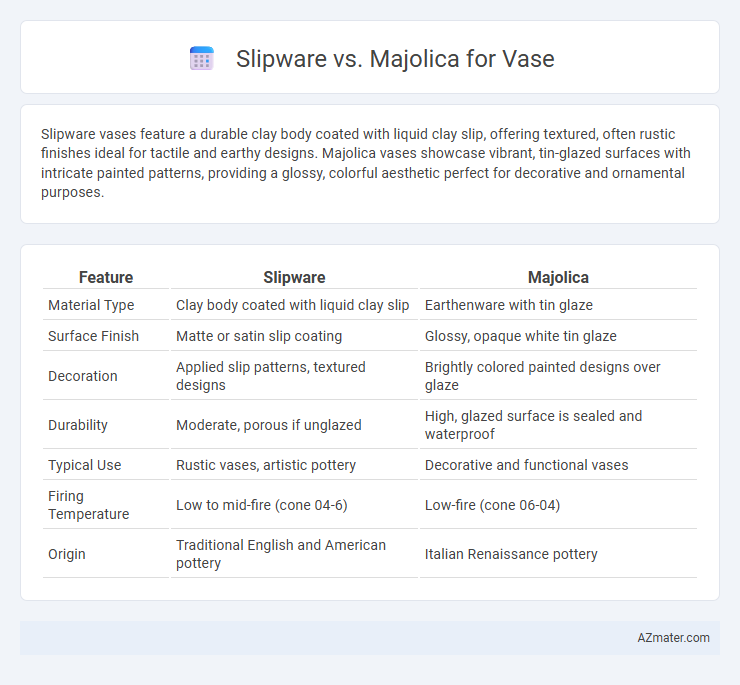Slipware vases feature a durable clay body coated with liquid clay slip, offering textured, often rustic finishes ideal for tactile and earthy designs. Majolica vases showcase vibrant, tin-glazed surfaces with intricate painted patterns, providing a glossy, colorful aesthetic perfect for decorative and ornamental purposes.
Table of Comparison
| Feature | Slipware | Majolica |
|---|---|---|
| Material Type | Clay body coated with liquid clay slip | Earthenware with tin glaze |
| Surface Finish | Matte or satin slip coating | Glossy, opaque white tin glaze |
| Decoration | Applied slip patterns, textured designs | Brightly colored painted designs over glaze |
| Durability | Moderate, porous if unglazed | High, glazed surface is sealed and waterproof |
| Typical Use | Rustic vases, artistic pottery | Decorative and functional vases |
| Firing Temperature | Low to mid-fire (cone 04-6) | Low-fire (cone 06-04) |
| Origin | Traditional English and American pottery | Italian Renaissance pottery |
Introduction to Slipware and Majolica
Slipware and Majolica are traditional ceramic techniques distinguished by their decorative approaches and firing processes. Slipware utilizes a liquid clay mixture called slip, applied to the surface for intricate designs or texture before firing, often resulting in earthy, rustic finishes. Majolica features tin-glazed earthenware with vivid, opaque colors and a glossy surface, achieved by applying a lead glaze over the painted slip before firing at lower temperatures.
Historical Origins and Evolution
Slipware pottery, originating in the Neolithic period, uses liquid clay slip to create decorative surfaces and has evolved through cultures like the Romans and English potters in the 17th century. Majolica, developed during the Italian Renaissance, is a tin-glazed technique renowned for its vibrant, opaque surface ideal for detailed painting and became prominent in Mediterranean ceramics. Both styles reflect historical adaptation to material availability and artistic trends, influencing vase decoration methods across Europe.
Material Composition and Techniques
Slipware vases feature a clay body coated with a liquid mixture of clay and water called slip, which allows for intricate designs through painting or trailing before firing; the slip creates a smooth, matte surface often decorated with contrasting colors. Majolica vases use a porous earthenware clay coated with a tin oxide glaze that creates a white, opaque surface ideal for vibrant, detailed painted designs applied over the glaze and then fired at lower temperatures. The primary difference lies in slipware's use of slip for decoration and texture, while majolica employs a tin-glazed surface enabling bright, glossy finishes and richer color palettes.
Distinctive Aesthetic Features
Slipware vases showcase distinctive, earthy textures created by layering liquid clay slip, often resulting in rustic, hand-crafted patterns with a matte finish. Majolica vases are characterized by their vibrant, glossy glazes and intricate, vividly colored motifs applied over a white tin-glazed surface. The contrast between slipware's organic, subdued palette and majolica's bright, polished appearance highlights their unique aesthetic identities.
Firing and Glazing Processes
Slipware vases utilize a liquid clay slip applied to the surface before firing, creating textured patterns that fuse during a single or low-temperature firing, often between 1,100degC and 1,200degC. Majolica vases feature a tin-opacified white glaze applied after the initial bisque firing, followed by a second firing at a lower temperature, typically around 950degC to 1,050degC, to fix brilliant, painted colors under the glaze. The firing temperature and glazing technique in slipware emphasize earthy, matte finishes, while majolica achieves glossy, vibrant surfaces due to its opaque tin-glaze and multiple firings.
Durability and Functional Qualities
Slipware vases exhibit enhanced durability due to their thick slip coating that creates a robust, chip-resistant surface, making them ideal for everyday use. Majolica, characterized by its tin-glazed earthenware with vibrant, glossy finishes, offers a more delicate structure prone to chipping and cracking under impact. The functional qualities of slipware prioritize resilience and longevity, while majolica emphasizes decorative appeal with less emphasis on heavy-duty use.
Decorative Styles and Motifs
Slipware vases showcase decorative styles characterized by fluid, earthy patterns achieved through slip trailing and layering techniques, often featuring organic motifs like leaves and abstract swirls. Majolica vases exhibit bright, glossy glazes with vibrant colors and intricate, pictorial motifs such as fruit, flowers, and mythological scenes, reflecting Renaissance influences. The tactile texture of slipware contrasts with the smooth, glass-like surface of majolica, highlighting distinct artistic traditions in ceramic decoration.
Popularity in Contemporary Ceramics
Slipware and majolica both hold significant popularity in contemporary ceramics, with slipware prized for its earthy textures and traditional hand-applied slip decoration that appeals to modern rustic aesthetics. Majolica remains favored for its vibrant, brightly-colored tin-glazed surfaces that provide bold, decorative visual impact in gallery pieces and functional vases. Collectors and artists often choose slipware for its tactile organic feel, while majolica is selected for its glossy finish and intricate painted patterns, reflecting differing trends in today's ceramic art market.
Collectibility and Market Value
Slipware vases, characterized by their decorative slip coatings and earthy tones, appeal to collectors seeking traditional craftsmanship and folk art authenticity, often commanding moderate market values influenced by regional styles and historical context. Majolica vases, with their vibrant, tin-glazed surfaces and intricate patterns, attract collectors prioritizing ornamental beauty and European heritage, typically achieving higher market prices due to their elaborate designs and rarity. Collectibility of both slipware and majolica is enhanced by factors such as provenance, condition, and maker, but majolica's striking visual appeal generally results in stronger demand among art investors and decorative art collectors.
Choosing Between Slipware and Majolica for Vases
Slipware vases feature a rustic, earthy finish created by applying liquid clay slip, resulting in textured surfaces and subdued tones ideal for organic, handcrafted aesthetics. Majolica vases, characterized by their vibrant, glossy tin-glazed surface, offer bright colors and intricate patterns that stand out as decorative centerpiece pieces. Choosing between slipware and majolica depends on the desired visual impact and style, where slipware suits natural, tactile decor and majolica excels in colorful, ornamental designs.

Infographic: Slipware vs Majolica for Vase
 azmater.com
azmater.com